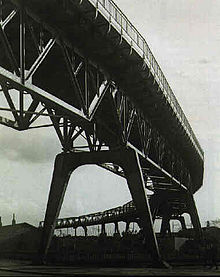Arvid Gutschow
Arvid Gutschow (* 1900 in Hamburg ; † 1984 ) was a German photographer. He is considered a representative of the New Objectivity .
life and work
From 1909 to 1918 Arvid Gutschow attended the humanistic grammar school in Hamburg. In the spring of 1918 he did military service for a few months. He then studied law in Kiel , Hamburg , Heidelberg and Munich . In 1923 he received his doctorate on the subject of overseas consignments, in particular the export commission . In 1926, after completing his traineeship and assessor exams, he joined the Hamburg civil service as a lawyer. In the Landherrenamt he was promoted to Senate Director. Already at this time he was self-taught as a photographer, but probably kept this largely secret for civil service reasons. In February 1927 his first publication appeared in The Lover Photography . Among other things, he photographed the new Hamburg office buildings , the port , industrial buildings , the Altona fish market , but also medieval brick architecture and landscapes such as the coasts of the North and Baltic Seas . His New Seeing style photos have been published in a number of magazines , illustrated books and exhibition catalogs.
In 1928 he married. On the honeymoon trip to Sylt , the photos for the 1930 photo book See, Sand, Sonne were taken with an introduction by Hans Leip .
Gutschow took part in the Werkbund Film and Photo Exhibition in Stuttgart in 1929 . His photos appeared in the anthology foto-auge , with which the editors Franz Roh and Jan Tschichold gave an overview of the contemporary photo avant-garde in 1929. In 1932 he exhibited at the International Photo Exhibition at the Hamburger Kunstverein .
In the volumes Das Deutsche Lichtbild from 1931 and 1932 it can be seen that Gutschow mainly took photos with a Stegemann camera with a plate format 9x12. In the mid-1930s he used a Leica .
In 1937 he became a member of the NSDAP , was otherwise politically inactive and led a rather reserved life. Around this time his photographic activities declined. Rather, he dealt with agricultural and urban planning issues. In 1945 he was assessed as "unencumbered" by the British military government and was able to remain in office. In 1947 he was retired at his own request.
From the 1950s onwards, Arvid Gutschow became more active in photography and took photos in the vicinity of his residence in Seebergen near Bremen. He also dealt again with industrial photography with photos by Hanomag and AG Weser in the new-objective style of his work from the 1920s. In 1956 he took a trip to India and took photos there. Independent publications no longer appeared.
family
He is the brother of the architect Konstanty Gutschow , who completed an internship on the construction site of the Chilehaus in Hamburg at the end of the 1920s .
Publications
Magazines
- The lovers photograph. Federal organ of the Lower Saxony district of the Association of German Amateur Photography Associations as a supplement to the Hamburg Foreign Gazette (1927)
- The cross section (1928 ff.)
- VU (No. 3, 1928)
- Eagle Owl (1928)
- Illustrirte Zeitung , Leipzig (1929)
- Verhagen & Klasings monthly notebooks (1929)
- The coral ( Ullstein Verlag , 1929 ff.)
- Illustrated weekly supplement of the Hamburger Anzeiger (26, 1930; 26, 1932)
- Atlantis. Countries, peoples, travel (1930 ff.)
- Altona News (1931)
- Hamburg-America-Post (1930-1933)
Hamburg illustrated books
- The port of Hamburg (1930)
- Hamburg's Worldwide Activities (1930)
- Hamburg (1934)
Illustrated books
- foto-auge (1929, Franz Roh and Jan Tschichold )
- Lake, sand, sun (1930, 1935)
- The German Photo (1931, 1932)
- The work (1931) from the series the blue books
- New Photo Art Calendar (1932)
- The tree in the picture of the landscape. Selected nature shots (1931), clouds over sea and land (1932), language of German landscape (1934) from the series Der Eiserne Hammer
- People and Fatherland (1932)
- Photography (Paris; 1932, 1935)
- German costumes (1936) from the Blue Books series
- Hearthfire (1936)
- The German North Sea (Atlantis-Verlag, 1937)
- Photographs: 1928–1956 , text and design: Hans Jürgen Sieker, Lilienthal: Sieker, 1984.
Further
- Overseas consignments, especially the Export Commission , Hamburg, 1923. [Maschinenschr.], Hamburg, Univ., Diss., 1923.
- Albrecht Jansen: Sun over Amrun (1935), illustration
Exhibitions
- Arvid Gutschow and Alfred Ehrhardt - related , 12 January - 17 March 2013, Alfred Ehrhardt Foundation Berlin ( homepage of the exhibition )
Individual evidence
- ↑ Roland Jaeger: Arvid Gutschow printed: the photographer's records in the book and the press , in: From the Antiquarian Book Shop , New Volume 10 (2012), No. 6, pp. 256–274, this also for further information.
- ^ Roland Jaeger: Arvid Gutschow printed [...], 2012, p. 268.
- ^ Roland Jaeger: Arvid Gutschow printed [...], 2012, p. 269.
- ^ Roland Jaeger: Arvid Gutschow printed [...], 2012, p. 270.
- ^ Roland Jaeger: Arvid Gutschow printed [...], 2012, p. 272.
- ^ Roland Jaeger: Arvid Gutschow printed [...], 2012, p. 282.
- ^ Roland Jaeger: Arvid Gutschow printed [...], 2012, p. 267.
literature
- Roland Jaeger: Arvid Gutschow printed: the photographer's work records in the book and press , in: From the Antiquarian Book Shop , New Volume 10 (2012), No. 6, pp. 256–274, with bibliography and work information.
- Stefanie Odenthal (Ed.): Arvid Gutschow , Hatje Cantz Verlag, Ostfildern 2012. ISBN 978-3-7757-3536-0 , ( [1] content)
Web links
- Literature by and about Arvid Gutschow in the catalog of the German National Library
- Arvid Gutschow on artnet.de
| personal data | |
|---|---|
| SURNAME | Gutschow, Arvid |
| BRIEF DESCRIPTION | German photographer |
| DATE OF BIRTH | 1900 |
| PLACE OF BIRTH | Hamburg |
| DATE OF DEATH | 1984 |


